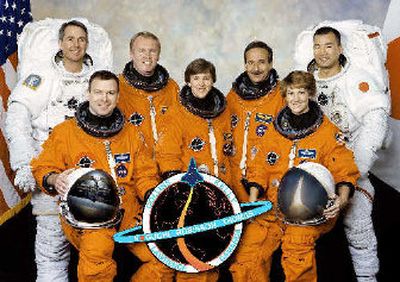Go to launch

CAPE CANAVERAL, Fla. – A protective cover fell off one of space shuttle Discovery’s windows Tuesday and struck the heat shield near the vehicle’s tail, 60 feet below. But workers replaced the damaged section, and the countdown for today’s scheduled launch continued.
NASA engineers planned to work into the night to study whether the blow could have damaged structures beneath the heat shield, but vehicle manager Stephanie Stilson said shuttle officials “are very confident” that there won’t be a serious problem. The window covers are removed before launch.
Tuesday’s incident was a reminder of the Columbia disaster in February 2003. A chunk of fuel-tank debris damaged that craft’s heat shield, and Columbia disintegrated as it re-entered the atmosphere, killing all seven aboard.
If the weather cooperates, seven astronauts aboard Discovery will soar into space at 12:51 p.m. PDT today on the first shuttle flight since the deadly accident.
“We have come through a very difficult time at NASA,” space agency Administrator Michael Griffin said Tuesday. “We’re back online and ready to go.”
Griffin said that technical problems that remained at the final pre-launch review Monday had been resolved.
There is a 40 percent chance that bad weather will prevent the launch today, shuttle weather officer Kathy Winters said. The main threat: thunderstorms that could drift too close to the shuttle’s landing strip at launch time. The skies above the strip need to be clear to allow the shuttle to make an emergency landing just after liftoff if necessary.
A lot is riding on this afternoon’s sea breezes in central Florida. Returning the shuttle to space is the first step in President Bush’s plan to send Americans back to the moon. Griffin has said that if this flight and the next go well, he will send astronauts to repair the Hubble Space Telescope.
Griffin said he would not view a successful shuttle mission as a vindication for the agency, which was accused of arrogance and complacency after the Columbia accident.
“There is no recovery from the mistakes we’ve made,” he said. “The minute we say we’re good enough, we start getting bad again.”
Griffin also said that NASA would soon have to abandon plans to house shuttle crews on the International Space Station in case of trouble.
NASA had said after the accident that it would keep another shuttle ready to retrieve a stranded crew for the next two missions. But the demands of building the station will make the rescue capability impossible to sustain, Griffin said.
“We will have to … make a decision that our engineering improvements … are either good enough to fly or are not yet good enough to fly,” he said.
Griffin’s statement was the first time a NASA official had said definitively that the rescue plan would have to end.
If NASA doesn’t send Discovery into space today, the shuttle could be readied again for launch Thursday or Saturday. NASA officials are keeping an eye on Tropical Storm Emily, which is churning in the Atlantic toward the Caribbean.